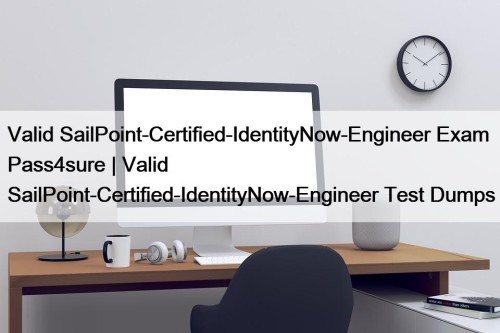Most Popular
 CIDQ IDFX Test Lab Questions & Exam IDFX Material
CIDQ IDFX Test Lab Questions & Exam IDFX Material
In order to help customers, who are willing to buy ...
 Valid SailPoint-Certified-IdentityNow-Engineer Exam Pass4sure | Valid SailPoint-Certified-IdentityNow-Engineer Test Dumps
Valid SailPoint-Certified-IdentityNow-Engineer Exam Pass4sure | Valid SailPoint-Certified-IdentityNow-Engineer Test Dumps
The result of your exam is directly related with the ...
 Adobe AD0-E608 Valid Dumps Sheet | AD0-E608 Test Collection
Adobe AD0-E608 Valid Dumps Sheet | AD0-E608 Test Collection
Knowledge is a great impetus for the progress of human ...



Latest SPLK-5002 Braindumps Files, SPLK-5002 Valid Exam Tutorial

To achieve this objective the TestPassed is offering some important and easy-to-use features in TestPassed SPLK-5002 practice test questions. The first feature of TestPassed SPLK-5002 exam questions is its availability of Splunk Certified Cybersecurity Defense Engineer SPLK-5002 exam questions in three formats. These formats hold a high demand in the market and are recommended for instant Splunk SPLK-5002 exam preparation. The name of these three TestPassed SPLK-5002 exam questions formats is PDF dumps file, desktop practice test software, and web-based practice test software. All these TestPassed SPLK-5002 Exam Questions formats are easy to use and compatible with all devices, operating systems, and the latest browsers. Choose any TestPassed SPLK-5002 exam questions format that suits your budget and fulfills your Splunk Certified Cybersecurity Defense Engineer SPLK-5002 exam preparation need and start preparing today.
Splunk SPLK-5002 Exam Syllabus Topics:
| Topic | Details |
|---|---|
| Topic 1 |
|
| Topic 2 |
|
| Topic 3 |
|
| Topic 4 |
|
| Topic 5 |
|
>> Latest SPLK-5002 Braindumps Files <<
SPLK-5002 Valid Exam Tutorial & SPLK-5002 Latest Real Exam
It is not just an easy decision to choose our SPLK-5002 prep guide, because they may bring tremendous impact on your individuals development. Holding a professional certificate means you have paid more time and effort than your colleagues or messmates in your major, and have experienced more tests before succeed. Our SPLK-5002 real questions can offer major help this time. And our SPLK-5002 study braindumps deliver the value of our services. So our SPLK-5002 real questions may help you generate financial reward in the future and provide more chances to make changes with capital for you and are indicative of a higher quality of life.
Splunk Certified Cybersecurity Defense Engineer Sample Questions (Q34-Q39):
NEW QUESTION # 34
A company wants to implement risk-based detection for privileged account activities.
Whatshould they configure first?
- A. Event sampling for raw data
- B. Correlation searches with low thresholds
- C. Automated dashboards for all accounts
- D. Asset and identity information for privileged accounts
Answer: D
Explanation:
Why Configure Asset & Identity Information for Privileged Accounts First?
Risk-based detection focuses on identifying and prioritizing threats based on the severity of their impact. For privileged accounts (admins, domain controllers, finance users), understanding who they are, what they access, and how they behave is critical.
#Key Steps for Risk-Based Detection in Splunk ES:1##Define Privileged Accounts & Groups - Identify high- risk users (Admin, HR, Finance, CISO).2##Assign Risk Scores - Apply higher scores to actions involving privileged users.3##Enable Identity & Asset Correlation - Link users to assets for better detection.
4##Monitor for Anomalies - Detect abnormal login patterns, excessive file access, or unusual privilege escalation.
#Example in Splunk ES:
A domain admin logs in from an unusual location # Trigger high-risk alert A finance director downloads sensitive payroll data at midnight # Escalate for investigation Why Not the Other Options?
#B. Correlation searches with low thresholds - May generate excessive false positives, overwhelming the SOC.#C. Event sampling for raw data - Doesn't provide context for risk-based detection.#D. Automated dashboards for all accounts - Useful for visibility, but not the first step for risk-based security.
References & Learning Resources
#Splunk ES Risk-Based Alerting (RBA): https://www.splunk.com/en_us/blog/security/risk-based-alerting.
html#Privileged Account Monitoring in Splunk: https://docs.splunk.com/Documentation/ES/latest/User
/RiskBasedAlerting#Implementing Privileged Access Security (PAM) with Splunk: https://splunkbase.splunk.
com
NEW QUESTION # 35
What is the primary function of summary indexing in Splunk reporting?
- A. Enhancing the accuracy of alerts
- B. Normalizing raw data for analysis
- C. Creating pre-aggregated data for faster reporting
- D. Storing unprocessed log data
Answer: C
Explanation:
Primary Function of Summary Indexing in Splunk Reporting
Summary indexing allows pre-aggregation of data to improve performance and speed up reports.
#Why Use Summary Indexing?
Reduces processing time by storing computed results instead of raw data.
Helps SOC teams generate reports faster and optimize search performance.
Example:
Instead of searching millions of firewall logs in real-time, a summary index stores daily aggregated counts of blocked IPs.
#Incorrect Answers:
A: Storing unprocessed log data # Raw logs are stored in primary indexes, not summary indexes.
C: Normalizing raw data for analysis # Normalization is handled by CIM and data models.
D: Enhancing the accuracy of alerts # Summary indexing improves reporting performance, not alert accuracy.
#Additional Resources:
Splunk Summary Indexing Guide
Optimizing SIEM Reports in Splunk
NEW QUESTION # 36
What are the essential components of risk-based detections in Splunk?
- A. Alerts, notifications, and priority levels
- B. Risk modifiers, risk objects, and risk scores
- C. Summary indexing, tags, and event types
- D. Source types, correlation searches, and asset groups
Answer: B
Explanation:
What Are Risk-Based Detections in Splunk?
Risk-based detections in Splunk Enterprise Security (ES) assign risk scores to security events based on threat severity and asset criticality.
#Key Components of Risk-Based Detections:1##Risk Modifiers - Adjusts risk scores based on event type (e.
g., failed logins, malware detections).2##Risk Objects - Entities associated with security events (e.g., users, IPs, devices).3##Risk Scores - Numerical values indicating the severity of a risk.
#Example in Splunk Enterprise Security:#Scenario: A high-privilege account (Admin) fails multiple logins from an unusual location.#Splunk ES applies risk-based detection:
Failed logins add +10 risk points
Login from a suspicious country adds +15 points
Total risk score exceeds 25 # Triggers an alert
Why Not the Other Options?
#B. Summary indexing, tags, and event types - Summary indexing stores precomputed data, but doesn't drive risk-based detection.#C. Alerts, notifications, and priority levels - Important, but risk-based detection is based on scoring, not just alerts.#D. Source types, correlation searches, and asset groups - Helps in data organization, but not specific to risk-based detections.
References & Learning Resources
#Splunk ES Risk-Based Alerting Guide: https://docs.splunk.com/Documentation/ES#Risk-Based Detections
& Scoring in Splunk: https://www.splunk.com/en_us/blog/security/risk-based-alerting.html#Best Practices for Risk Scoring in SOC Operations: https://splunkbase.splunk.com
NEW QUESTION # 37
During a high-priority incident, a user queries an index but sees incomplete results.
Whatis the most likely issue?
- A. The search head configuration is outdated.
- B. Data normalization was not applied.
- C. Indexers have reached their queue capacity.
- D. Buckets in the warm state are inaccessible.
Answer: C
Explanation:
If a user queries an index during a high-priority incident but sees incomplete results, it is likely that the indexers are overloaded, causing queue bottlenecks.
Why Indexer Queue Capacity Issues Cause Incomplete Results:
When indexing queues fill up, incoming data cannot be processed efficiently.
Search results may be incomplete or delayed if events are still in the indexing queue and not fully written to disk.
Heavy search loads during incidents can also increase pressure on indexers.
How to Fix It:
Monitor indexing queues via the Monitoring Console (indexing>indexing performance).
Checkmetrics.logon indexers formax_queue_size_exceededwarnings.
Increase indexer capacity or optimize search scheduling to reduce load.
NEW QUESTION # 38
A company wants to create a dashboard that displays normalized event data from various sources.
Whatapproach should they use?
- A. Apply search-time field extractions.
- B. Configure a summary index.
- C. Use SPL queries to manually extract fields.
- D. Implement a data model using CIM.
Answer: D
Explanation:
When organizations need to normalize event data from various sources, using Common Information Model (CIM) in Splunk is the best approach.
Why Use CIM for Normalized Event Data?
Standardizes Data Across Different Log Sources
CIM ensures consistent field names and formats across varied log types.
Makes searches, reports, and dashboards easier to manage.
Enables Faster and More Efficient Searches
Uses Data Models to accelerate search queries.
Reduces the need for custom field extractions.
NEW QUESTION # 39
......
Our SPLK-5002 study materials are designed carefully. We have taken all your worries into consideration. Also, we adopt the useful suggestions about our SPLK-5002 study materials from our customers. Now, our study materials are out of supply. Thousands of people will crowd into our website to choose the SPLK-5002 study materials. So people are different from the past. Learning has become popular among different age groups. Our SPLK-5002 Study Materials truly offer you the most useful knowledge. You can totally trust us. We are trying our best to meet your demands. Why not give our SPLK-5002 study materials a chance? Our products will live up to your expectations.
SPLK-5002 Valid Exam Tutorial: https://www.testpassed.com/SPLK-5002-still-valid-exam.html
- www.dumpsquestion.com Splunk SPLK-5002 Exam Study Material: Your Ultimate Guide ⛑ Search for ⇛ SPLK-5002 ⇚ and download it for free on ▛ www.dumpsquestion.com ▟ website 🍮SPLK-5002 Brain Dump Free
- Pass Guaranteed Quiz Pass-Sure SPLK-5002 - Latest Splunk Certified Cybersecurity Defense Engineer Braindumps Files 🔧 Search for ➤ SPLK-5002 ⮘ and download it for free on [ www.pdfvce.com ] website 🦳SPLK-5002 Premium Files
- Dump SPLK-5002 Collection 🍐 SPLK-5002 Reliable Exam Pattern 🧭 Dump SPLK-5002 Collection 🙇 Search on ☀ www.torrentvce.com ️☀️ for { SPLK-5002 } to obtain exam materials for free download 🤐SPLK-5002 Brain Dump Free
- SPLK-5002 Latest Braindumps Ebook 🛺 SPLK-5002 Latest Cram Materials 🥅 Reliable SPLK-5002 Test Experience 🤵 Open website “ www.pdfvce.com ” and search for ▶ SPLK-5002 ◀ for free download 🔽Reliable SPLK-5002 Real Test
- Interactive SPLK-5002 EBook 🌜 SPLK-5002 Valid Exam Test 🥁 SPLK-5002 Brain Dump Free 🔻 Open ▶ www.dumpsquestion.com ◀ enter ➽ SPLK-5002 🢪 and obtain a free download 🍘SPLK-5002 Premium Files
- Pdfvce Splunk SPLK-5002 Exam Study Material: Your Ultimate Guide 🕖 Easily obtain free download of ✔ SPLK-5002 ️✔️ by searching on ➡ www.pdfvce.com ️⬅️ 🏯SPLK-5002 Braindumps Torrent
- Pass Guaranteed Quiz Splunk - Professional SPLK-5002 - Latest Splunk Certified Cybersecurity Defense Engineer Braindumps Files 💓 Download “ SPLK-5002 ” for free by simply entering { www.prep4away.com } website 🦞SPLK-5002 Certification Torrent
- Free PDF Splunk - Professional SPLK-5002 - Latest Splunk Certified Cybersecurity Defense Engineer Braindumps Files 🧳 Download ➡ SPLK-5002 ️⬅️ for free by simply entering ➥ www.pdfvce.com 🡄 website 📷SPLK-5002 Latest Cram Materials
- Pass Guaranteed Quiz Splunk - Professional SPLK-5002 - Latest Splunk Certified Cybersecurity Defense Engineer Braindumps Files 🍼 Search for ▶ SPLK-5002 ◀ on ▶ www.free4dump.com ◀ immediately to obtain a free download 🚨SPLK-5002 Latest Braindumps Ebook
- Pass Guaranteed Quiz Splunk - Professional SPLK-5002 - Latest Splunk Certified Cybersecurity Defense Engineer Braindumps Files 🏣 Open website ⏩ www.pdfvce.com ⏪ and search for ☀ SPLK-5002 ️☀️ for free download 👛SPLK-5002 Certification Torrent
- SPLK-5002 Braindumps Torrent 🛐 Test SPLK-5002 Dumps Demo 🌮 Test SPLK-5002 Dumps Demo 🕸 ⇛ www.torrentvalid.com ⇚ is best website to obtain 【 SPLK-5002 】 for free download ⏪SPLK-5002 Certification Torrent
- SPLK-5002 Exam Questions
- dynamictechworld.in academy.iluvquran.com arrayholding.com mdiaustralia.com www.kkglobal.ng quicklearnu.com bsxq520.com internshub.co.in academy.businessmarketingagency.com.au glowegacademy.com
Tags: Latest SPLK-5002 Braindumps Files, SPLK-5002 Valid Exam Tutorial, SPLK-5002 Latest Real Exam, Latest SPLK-5002 Test Prep, SPLK-5002 Test Online